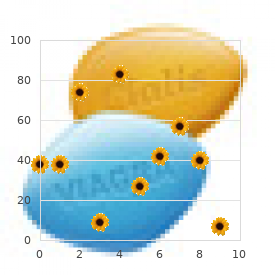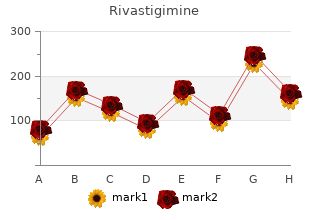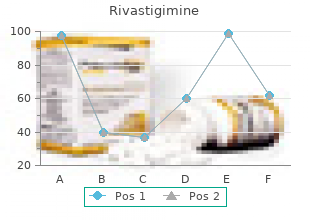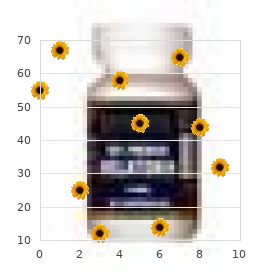Rivastigimine
"Order cheapest rivastigimine, treatment quad tendonitis".
By: U. Masil, M.B.A., M.B.B.S., M.H.S.
Professor, Duquesne University College of Osteopathic Medicine
The manifestation of transvestism in penile erection and stimulation medications for schizophrenia discount rivastigimine 3mg overnight delivery, like the manifesta� tion of other paraphilic as well as normophiHc sexual interests treatment lead poisoning generic rivastigimine 1.5mg without prescription, is most intense in adolescence and early adulthood medications safe in pregnancy generic rivastigimine 3 mg without prescription. The severity of transvestic disorder is highest in adulthood, when the transvestic drives are most likely to conflict with performance in heterosexual intercourse and desires to marry and start a family. Middle-age and older men with a history of trans� vestism are less likely to present with transvestic disorder than with gender dysphoria. Functional Consequences of Transvestic Disorder Engaging in transvestic behaviors can interfere with, or detract from, heterosexual rela� tionships. This can be a source of distress to men who wish to maintain conventional mar� riages or romantic partnerships with women. Individuals with transvestic disorder do not report an incongruence be� tween their experienced gender and assigned gender nor a desire to be of the other gender; and they typically do not have a history of childhood cross-gender behaviors, which would be present in individuals with gender dysphoria. Individuals with a presentation that meets fuU criteria for transvestic disorder as weU as gender dysphoria should be given both diagnoses. Comorbidity Transvestism (and thus transvestic disorder) is often found in association with other para� philias. One particularly dangerous form of masochism, autoerotic asphyxia, is associated with transves� tism in a substantial proportion of fatal cases. The other specified paraphilic disorder category is used in situations in which the clinician chooses to communicate the specific reason that the presentation does not meet the criteria for any specific paraphilic disorder. Examples of presentations that can be specified using the �other specified�designation include, but are not limited to, recurrent and intense sexual arousal involving telephone scatologia (obscene phone calls), necrophilia (coflses), zoophilia (animals), coprophilia (feces), klismaphilia (enemas), orurophilia (urine) that has been present for at least 6 months and causes marked distress or impairment in social, occupational, or other important ar� eas of functioning. Other specified paraphilic disorder can be specified as in remission and/or as occurring in a controlled environment. The unspecified paraphilic dis� order category is used in situations inwhich the clinician chooses not to specify the reason that the criteria are not met for a specific paraphilic disorder, and includes presentations in which there is insufficient information to make a more specific diagnosis. For other specified and unspecified mental disorders due to another medical condition, it must be established that the disturbance is caused by the physiolog� ical effects of another medical condition. If other specified and unspecified mental disor� ders are due to another medical condition, it is necessary to code and list the medical condition first. The other specified mental disorder due to another medical condition category is used insituations in which the clinician chooses to communicate the specific reason that the presentation does not meet the criteria for any specific mental disorder attributable to another medical condition. This is done by recording the name of the disorder, with the specific etiological medical condition inserted in place of �another medical condition,�fol� lowed by the specific symptomatic manifestation that does not meet the criteria for any specific mental disorder due to another medical condition. Furthermore, the diagnostic code for the specific medical condition must be listed immediately before the code for the other specified mental disorder due to another medical condition. For example, dissocia� tive symptoms due to complex partial seizures would be coded and recorded as 345. An example of a presentation that can be specified using the �other specified� desig� nation is the following: Dissociative symptoms: this includes symptoms occurring, for example, in the con� text of complex partial seizures. The unspecified mental disorder due to another medical condition category is used in sit� uations in which the clinician chooses nof to specify the reason that the criteria are not met for a specific mental disorder due to another medical condition, and includes presentations for which there is insufficient information to make a more specific diagnosis. This is done by recording the name of the disorder, with the specific etiological medical condition inserted in place of �another medical condition. For exam� ple, dissociative symptoms due to complex partial seizures would be coded and recorded as 345. The other specified mental disorder category is used in situations in which the clinician chooses to communicate the specific reason that the presentation does not meet the criteria for any specific mental disorder. This is done by recording �other specified mental disorder�followed by the specific reason. The unspecified mental disorder category is used in situations in which the clinician chooses not to specify the reason that the criteria are not met for a specific mental disorder, and includes presentations for which there is insufficient information to make a more specific diagnosis. Although these movement disorders are labeled "medication in� duced," it is often difficult to establish the causal relationship between medication expo� sure and the development of the movement disorder, especially because some of these movement disorders also occur in the absence of medication exposure. The term neuroleptic is becoming outdated because it highlights the propensity of an� tipsychotic medications to cause abnormal movements, and it is being replaced with the term antipsychotic in many contexts. Although newer antipsychotic medications may be less likely to cause some medication-induced movement disorders, those disorders still occur. Neuroleptic medications include so-called conventional, "typical," or first-generation antipsychotic agents.



Two-stage laparoscopic management of generalized peritonitis due to medications causing tinnitus order rivastigimine online pills perforated sigmoid diverticula: eighteen cases symptoms gonorrhea order rivastigimine with paypal. Laparoscopic resection does not adversely affect early survival curves in patients undergoing surgery for colorectal adenocarcinoma treatment 8th feb rivastigimine 6mg with mastercard. A prospective, randomized trial comparing laparoscopic versus conventional techniques in colorectal cancer surgery: a preliminary report. A prospective comparison of laparoscopy and imaging in the staging of esophagogastric cancer before surgery. Lymphovascular clearance in laparoscopically assisted right hemicolectomy is similar to open surgery. Peritoneal mucinous carcinomatosis after laparoscopic-assisted anterior resection for early rectal cancer: report of a case. Value of peritoneal lavage cytology during laparoscopic staging of patients with gastric carcinoma. Preoperative morbidity and anaesthesia-related negative events in patients undergoing conventional or laparoscopic cholecystectomy. Impairment of cardiac performance by laparoscopy in patients receiving positive end-expiratory pressure. Advanced age: indication or contraindication for laparoscopic colorectal surgeryfl Laparoscopic surgery in a patient with a ventriculoperitoneal shunt: a new technique. Laparoscopic cholecystectomy in pregnancy: a review of published experiences and clinical considerations. Professor and Chair Anesthesiology Department University of Nebraska Medical Center Richard R. Associate Professor and Associate Professor Chief, Section of Cardiology Anesthesiology Barbara J. Professor, Anesthesiology Medical Director, Anesthesia Preoperative Evaluation Unit Barbara J. Graphic Designer University of Nebraska Medical Center 2006 1 Preoperative preparation of the patient for non-cardiac surgery may be complex. The variety of presenting conditions may be diffcult to defne prior to surgery: � What tests should be orderedfl The following collection of information from many sources is designed to be a quick reference for anyone who is involved in the preparation of the patient for non-cardiac surgery. These are proposed guidelines and in no way should supersede good clinical evaluation and assessment. The crux of this handout is the algorithm which outlines the preoperative cardiac assessment. Although I generally agree with this outline, there were a few places which may result in unnecessary preoperative noninvasive testing: 1. Under Step 6 in patients with moderate or excellent functional capacity undergoing high-risk surgical procedures. I am assuming that the high-risk procedures may include lower extremity bypass, aortic aneurysm repair, and carotid endarterectomy. There is, to my knowledge, no good data to support a role for coronary revascularization in a patient with moderate or excellent functional capacity. I would suggest at this decision point that a second option would be to undergo an operation with invasive preoperative monitoring and optimization. Under Step 7 in the high surgical risk procedure group with minor clinical predictors, I would also suggest that a decision be made prior to noninvasive testing to consider a surgical procedure with invasive preoperative monitoring. These decisions should be made between the surgeon and the patient with the understanding of what the risk entails. An article published in the Journal of the American Medical Association, which used computer modeling to assist the outcome of vascular surgery in patients who were moderately or mildly symptomatic, demonstrated an increased mortality in patients who underwent a preoperative evaluation. This was related to the fact that coronary revascularization, because of its own inherent risks, does not lower the overall operative mortality. Therefore, I would submit that we may be doing patients a disservice in these categories by not giving them the option of going directly to surgery.

Institutions may fail to treatment genital herpes rivastigimine 1.5 mg with mastercard capitalize on their shared values by introducing audit or compliance-related management systems and processes based on lack of trust (and in contradiction of the ethics of most academic organisations) which substantially increase internal transaction costs symptoms 7dpo rivastigimine 3 mg overnight delivery, reducing the overall capital value medicine lake montana order rivastigimine in india, and wasting investment which might be put to better use. Libraries themselves may introduce systems and processes which increase transaction costs due to lack of trust between different internal departments. Transaction cost theory is not new (Coase, 1937) and leads to ideas of the value of social capital, which is a component of relational value that can also be assessed by libraries. If positive social capital is built with users, partners and other stakeholders, then transaction costs can be managed down, providing a tangible benefit to outcomes. This requires a focus on �those costs associated with human interaction� (Fussell et al, 2006). It is hard to find much discussion of these ideas in the library related literature, which is surprising given the historical recognition that research libraries have given to the importance of relationships with their academic communities. In simple terms it can be said that social capital and trust are in inverse proportion to transaction costs. It should also be noted that social capital cannot be built on one�s own, therefore positive engagement with stakeholders is not a luxury but an economic necessity. In summary, effective relationships add value and save cost where they build trust; so human interaction measures are a key indicator of value, and hence the allocation of one of the four dimensions of the value scorecard to relationship value. This is also encapsulated in the concept of social intelligence suggested by Anglada (quoting Marina, 2004) and bluntly expressed thus: �There are intelligent [libraries] and stupid [libraries] intelligent groups gather information better and adapt better to reality thus we find �social intelligence�� (Anglada, 2007). The idea of a socially intelligent library requires a measurement framework to assess and demonstrate this value. Relationship strength and marketing frameworks By now it will be clear that there is a link between library marketing (in its broadest sense) and the relationship value for which measurement is sought. To achieve practical measurement of the web of relationships in which any library is engaged, there needs to be both a way of analysing that web, and a way of quantifying the relationship with each partner or stakeholder group. To take the latter question first, one way of assessing each relationship is to apply a value to its strength. This might provide a potential route for libraries to take in assessing their relationships. A foundation idea here is the �commitment-trust theory of relationship marketing� (Morgan & Hunt, 1994). This concept encompasses relational marketing, working partnerships, and strategic alliances, and internal marketing. It also suggests a framework which might cover all the different types of relationship that an academic or research library might have, which when each is quantified using a strength index might add up to an overall assessment of relationship value. It is also fitting to note that Morgan & Hunt acknowledge the influence of Parasuraman and co-workers, given the subsequent application of Parasuraman�s work to library service quality assessment, and his keynote at our 5th Northumbria Conference (Parasuraman, 2004). Relationship marketing ideas have been further developed in the interim, particularly to take account of more modern theories of forms of organization in the digital environment. In a proposition for �total relationship management� (Gummeson, 2004) a list of thirty relationships (30 Rs) is provided covering: l Classic market relationships l Special market relationships l Mega relationships l Nano relationships. Many of these are relevant to libraries within parent institutions that have complex relationships with a variety of stakeholder groups; and some others reflect important operational service level interactions critical to good relationships. Newly developing value elements may also require inclusion, as libraries form relationships through new social media. The value of consumer interaction as intellectual capital developed via these routes needs to be added to the overall assessment (Susann, 2012). A final framework proposition is a market model that encompasses all the likely relationships an organisation may have within a simple typology. The next section is a historical diversion to strengthen the rationale for libraries to assess their relationship value. These staff members focus on one or a number of particular disciplines comprising the library�s market. What follows are some application cases in libraries on these people, and their markets and relationships. The intent here is to reveal some evidence from past experience which might highlight the important and specific measures which might be relevant to populating the relationship capital dimension of the value scorecard in the academic and research library context. The first historical example chosen relates to the author�s background in medical libraries, in which the concept of an embedded (subject specialist) librarian was developed and tested, to achieve direct impact on patient care (Lamb, 1976). The important aspects of these �clinical librarians� for relationship measurement are the notion of �the clinical librarian as a member of the patient care team� and as �a valuable interface the key to better patient care�.

Syndromes
- Acute respiratory failure
- Medicine to cause early labor and delivery of the baby
- Weakness
- Supervise young children at all times.
- A major life event, such as the loss of a loved one or a traumatic event
- Complete blood count (CBC)
- Allergic reaction to toothpaste, mouthwash, breath fresheners, dyes in candy, plastic in dentures or retainers, or certain blood pressure medications (ACE inhibitors)
- Low blood pressure

While the characteristics of the parasite or disease severity relate to medicine to prevent cold cheap rivastigimine 4.5 mg on line trade medications on a plane effective 1.5 mg rivastigimine, it is largely a function of the food source or vehicle; if the primary food-borne pathway is not widely traded medicine hat alberta canada generic rivastigimine 3 mg amex, or not currently traded from a region in which the parasite is currently endemic, it may not be likely to have an impact on trade. At the same time, if the parasite is in a food product that is widely traded or if there are current issues associated with the parasite-food pathway, it is of greater relevance. Distributional impacts (socio-economic impact) Criterion: Scope of impact to economically vulnerable populations Explanation: this criterion refects the degree to which this disease afects economically vulnerable communities, namely the extent to which this parasite causes reductions in household or community productivity, or the ability of a household or community to have access food. Vulnerable communities include pastoral communities, small fshing communities, small rural communities in developing countries, migrant populations in developed countries, minority indigenous populations (Inuit in Canada, aboriginals in Australia), or other similar communities. Ranges: bin 0 bin 1 bin 2 bin 3 None Low Moderate High Primarily afects individual Primarily impacts Afects entire households; afected individual households communities; households have reduced but also afects communities bear major productive capacity or communities; losses to productive have reduced access to households have capacity and/or have food reduced productive seriously diminished capacity or access to access to food. Quality of evidence Criterion: Quality of available evidence to support judgments (Not a scored criterion) Explanation: this question refects the extent to which you feel you were able to assess criterion-based data or information for a specifc parasite. Ranges: bin 0 bin 1 bin 2 bin 3 bin 4 Very Poor Poor Adequate Good Very Good Comments Lastly, please indicate comments, if any, that should be considered in the discussion of risk management for this parasite food pathway References Havelaar, A. Global burden of disease 2004 update: Disability weights for diseases and conditions. Otherwise the calculation is straightforward: normalized parasite criteria scores are multiplied by fractional weights. Criteria weights are simply the fraction of the total score refected by the criteria in question. Terefore, if you think 25% of the overall score should be driven by C1, W1 should be marked with a 25. For comparison purposes, equal weighting of all criteria would result in a value of 14. Make sure that all numbers sum to 100%, and that no criterion weight is less than 5%. Because each group scored a slightly diferent set of parasites, the average scores are not directly comparable, but they do show some interesting patterns. Criterion 2, on the global distribution of disease of each parasite, shows consisScaled Criteria Scores (0-1) 0. Group scores by criteria, averaged across parasites 54 Multi criteria-based ranking for risk ManageMent of food-borne parasites tently high average scores, which suggests that experts generally agreed that the set of screened pathogens refects parasites of global relevancy. The severity of chronic disease consistently scored higher than the severity of acute disease for this set of parasites. Overall, scores for illness trends were low, suggesting that current, endemic disease may be more of a concern than disease movement or emergence. Taenia solium Echinococcus granulosus Echinococcus multilocularis Toxoplasma gondii Cryptosporidium spp. Means and ranges of normalized risk scores across expert groups under baseline model conditions Annex 5 SenSitivity AnAlySiS 55 Just as there is variability across expert groups in average criteria scores across parasites, there is variability across groups for specifc parasites. Some parasites, such as Toxoplasma gondii, have relatively little variability across experts, while parasites such as Echinococcus multilocularis and Paragonimus, have notably larger variability. This variance can be interpreted as a signal of the strength of scientifc knowledge about a given parasite: the greater the variance, the greater the uncertainty in information available to experts. In examining sensitivity of the model itself, alternative weighting schemes were of particular interest. In some multi-criteria decision analyses, diferent groups of experts are used to score the individual criteria and to develop the weights that defne how criteria scores will be combined into a fnal risk score. Tat is, subject matter experts are elicited for criteria scores, while risk managers are elicited for criteria weights. The mean of elicited weights across all participants was used for the baseline model and ranking. Criterion weights were roughly similar across experts and risk managers, as shown in the rounded values presented in Table A5. Risk managers tended to put greater weight on potential for increased illness, trade relevance and impacts to economically vulnerable communities than did experts, but all participants tended to put greater weight on public health criteria. Tese are compared with an equal weighting scheme, in which each criterion is treated as of equal importance in the overall risk score. Sensitivity analyses of rankings were conducted around three alternative weighting schemes: mean of expert weights, mean of risk manager weights, and equal criteria weighting.
Cheap generic rivastigimine uk. Bronchitis - early signs of bronchitis - bronchitis symptoms don't ignore these - Dr. Joel Wallach.

